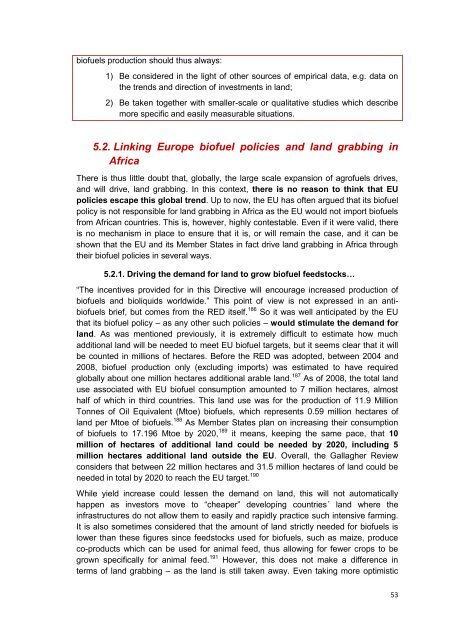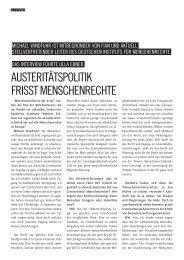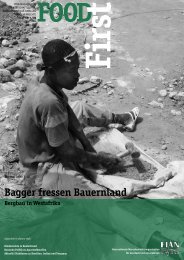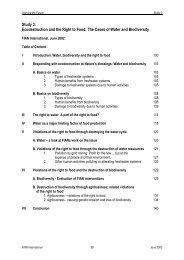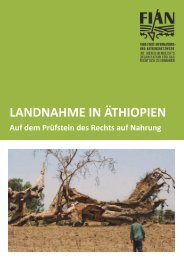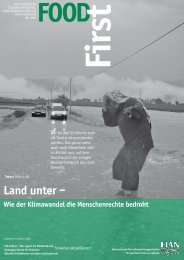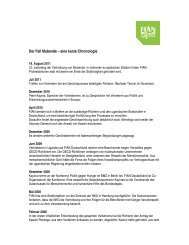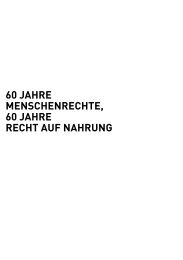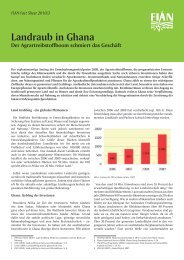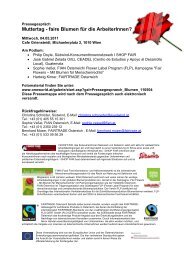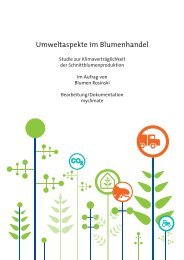(Bio)Fueling Injustice? - Europafrica
(Bio)Fueling Injustice? - Europafrica
(Bio)Fueling Injustice? - Europafrica
You also want an ePaper? Increase the reach of your titles
YUMPU automatically turns print PDFs into web optimized ePapers that Google loves.
iofuels production should thus always:<br />
1) Be considered in the light of other sources of empirical data, e.g. data on<br />
the trends and direction of investments in land;<br />
2) Be taken together with smaller-scale or qualitative studies which describe<br />
more specific and easily measurable situations.<br />
5.2. Linking Europe biofuel policies and land grabbing in<br />
Africa<br />
There is thus little doubt that, globally, the large scale expansion of agrofuels drives,<br />
and will drive, land grabbing. In this context, there is no reason to think that EU<br />
policies escape this global trend. Up to now, the EU has often argued that its biofuel<br />
policy is not responsible for land grabbing in Africa as the EU would not import biofuels<br />
from African countries. This is, however, highly contestable. Even if it were valid, there<br />
is no mechanism in place to ensure that it is, or will remain the case, and it can be<br />
shown that the EU and its Member States in fact drive land grabbing in Africa through<br />
their biofuel policies in several ways.<br />
5.2.1. Driving the demand for land to grow biofuel feedstocks…<br />
“The incentives provided for in this Directive will encourage increased production of<br />
biofuels and bioliquids worldwide.” This point of view is not expressed in an antibiofuels<br />
brief, but comes from the RED itself. 186 So it was well anticipated by the EU<br />
that its biofuel policy – as any other such policies – would stimulate the demand for<br />
land. As was mentioned previously, it is extremely difficult to estimate how much<br />
additional land will be needed to meet EU biofuel targets, but it seems clear that it will<br />
be counted in millions of hectares. Before the RED was adopted, between 2004 and<br />
2008, biofuel production only (excluding imports) was estimated to have required<br />
globally about one million hectares additional arable land. 187 As of 2008, the total land<br />
use associated with EU biofuel consumption amounted to 7 million hectares, almost<br />
half of which in third countries. This land use was for the production of 11.9 Million<br />
Tonnes of Oil Equivalent (Mtoe) biofuels, which represents 0.59 million hectares of<br />
land per Mtoe of biofuels. 188 As Member States plan on increasing their consumption<br />
of biofuels to 17.196 Mtoe by 2020, 189 it means, keeping the same pace, that 10<br />
million of hectares of additional land could be needed by 2020, including 5<br />
million hectares additional land outside the EU. Overall, the Gallagher Review<br />
considers that between 22 million hectares and 31.5 million hectares of land could be<br />
needed in total by 2020 to reach the EU target. 190<br />
While yield increase could lessen the demand on land, this will not automatically<br />
happen as investors move to “cheaper” developing countries´ land where the<br />
infrastructures do not allow them to easily and rapidly practice such intensive farming.<br />
It is also sometimes considered that the amount of land strictly needed for biofuels is<br />
lower than these figures since feedstocks used for biofuels, such as maize, produce<br />
co-products which can be used for animal feed, thus allowing for fewer crops to be<br />
grown specifically for animal feed. 191 However, this does not make a difference in<br />
terms of land grabbing – as the land is still taken away. Even taking more optimistic<br />
53


